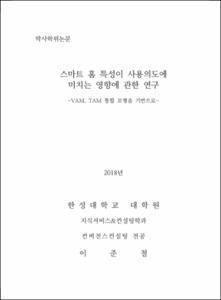스마트홈 특성이 사용의도에 미치는 영향에 관한 연구
= A Study on Influence of Smart Home Characteristics on Intention to Use : Based on VAM, TAM Integrated Model
- Type
- Thesis
- Alternative Title
- VAM, TAM 통합 모형을 기반으로
- Department
- 대학원 지식서비스&컨설팅학과
- Issued Date
- 2018
- Publisher
- 한성대학교 대학원
- Keyword
- 스마트홈; 기술수용모형(TAM); 가치기반수용모형(VAM); 스마트홈 특성; 안전성; 신뢰성; 내재성; 통제성; 상호연동성
- Appears in Collections:
- 지식서비스&컨설팅학과 > 1. Thesis
- Files in This Item:
-
-
Download
 200000003387.pdf
기타 데이터 / 2.07 MB / Adobe PDF
200000003387.pdf
기타 데이터 / 2.07 MB / Adobe PDF
-
Items in Repository are protected by copyright, with all rights reserved, unless otherwise indicated.